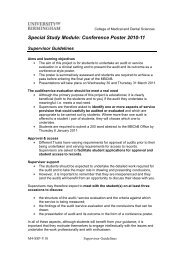Contents - College of Medical and Dental Sciences - University of ...
Contents - College of Medical and Dental Sciences - University of ...
Contents - College of Medical and Dental Sciences - University of ...
You also want an ePaper? Increase the reach of your titles
YUMPU automatically turns print PDFs into web optimized ePapers that Google loves.
The 11 th International Workshop on KSHV & Related Agents, Birmingham, UK<br />
Poster Session Abstract P3<br />
SEVERE CHANGES OF PHENOTYPE AND CYTOKINE EXPRESSION IN KSHV-<br />
INFECTED B-LYMPHOCYTES<br />
Guergana Iotzova 1 , Georg Malterer 1 , Kai Bratke 2 , Werner Luttmann 2 , Antoine Gessain 3 ,<br />
Christine S. Falk 4 , Kevin Robertson 5 , Peter Ghazal 5 <strong>and</strong> Jürgen Haas 1,5<br />
1 Max-von-Pettenk<strong>of</strong>er Institute, Ludwig-Maximilians-Universität München; 2 Department<br />
<strong>of</strong> Pneumology, <strong>University</strong> Hospital, Rostock; 3 Unit <strong>of</strong> Epidemiology <strong>and</strong> Physiopathology<br />
<strong>of</strong> Oncogenic Viruses, Institut Pasteur, Paris; 4 Institute for Molecular Immunology,<br />
Helmholtz Zentrum München; 5 Division <strong>of</strong> Pathway Medicine, <strong>University</strong> <strong>of</strong> Edinburgh,<br />
Edinburgh<br />
Abstract<br />
KSHV is involved in the pathogenesis <strong>of</strong> Kaposi´s sarcoma (KS) <strong>and</strong> B-cell derived<br />
primary effusion lymphomas (PEL). The aim <strong>of</strong> this study was to systematically<br />
investigate the influence <strong>of</strong> KSHV infection on the expression <strong>of</strong> cellular genes in B<br />
lymphocytes. To study these changes, a microarray analysis was performed with<br />
persistently in vitro KSHV-infected B-cells from several donors. A considerable number <strong>of</strong><br />
genes (408) were found to be modulated more than 4-fold by KSHV infection: 67.4% <strong>of</strong><br />
these genes were downregulated <strong>and</strong> 32.6% upregulated. Intriguingly, many<br />
downregulated genes encoded for B-cell surface markers <strong>and</strong> B-cell specific transcription<br />
factors (PAX-5, Oct-2 <strong>and</strong> Spi-B), which was confirmed on the protein level. The massive<br />
loss <strong>of</strong> B-cell surface markers or “null” phenotype was similar to PEL tumor cells<br />
suggesting that the loss <strong>of</strong> B-cell identity is caused by KSHV rather than cellular factors.<br />
KSHV-infected cells could not be lysed by allo-reactive cytotoxic T-cells, indicating that<br />
the null phenotype is associated with immune evasion. The downregulation <strong>of</strong> the Tolllike<br />
receptors TLR7, TLR9 <strong>and</strong> TLR10, which was confirmed by real-time PCR, might<br />
contribute to the immune escape <strong>of</strong> KSHV-infected B-cells. On the other h<strong>and</strong>, we<br />
detected a marked upregulation <strong>of</strong> Granzyme A (GzmA) transcripts in KSHV-infected<br />
cells, as well as exceedingly high levels <strong>of</strong> secreted GzmA in supernatants <strong>of</strong> KSHVinfected<br />
B-cells <strong>and</strong> in effusion fluids <strong>of</strong> PEL patients. shRNA knockdown studies revealed<br />
that GzmA participitates in a parakrine cytokine by inducing cellular IL-10, indicating a<br />
potential role <strong>of</strong> GzmA in the pathogenesis <strong>of</strong> KSHV-related PEL.<br />
Presenting author Email: malterer@mvp.uni-muenchen.de<br />
100















